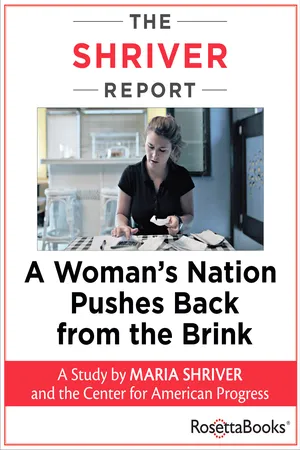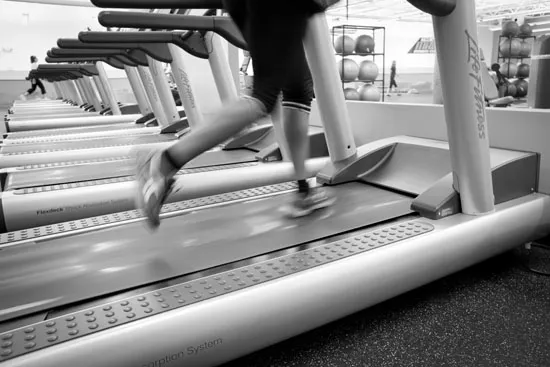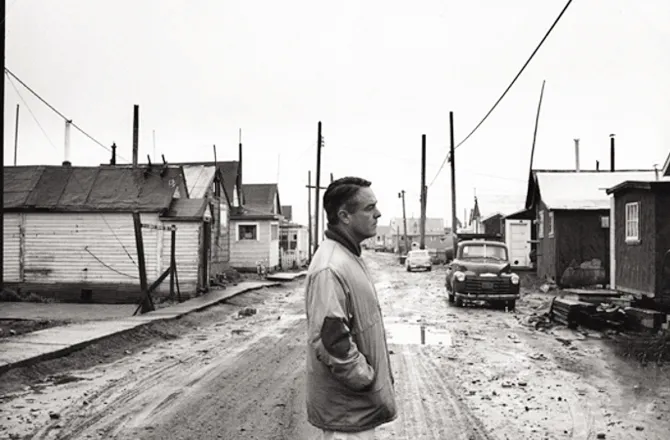
eBook - ePub
The Shriver Report
A Woman's Nation Pushes Back from the Brink
- 432 pages
- English
- ePUB (mobile friendly)
- Available on iOS & Android
eBook - ePub
The Shriver Report
A Woman's Nation Pushes Back from the Brink
About this book
Facts, figures, and essays on women and poverty by Barbara Ehrenreich, Kirsten Gillibrand, LeBron James, and other high-profile contributors.
Fifty years after President Lyndon B. Johnson called for a War on Poverty and enlisted Sargent Shriver to oversee it, the most important social issue of our day is once again the dire economic straits of millions of Americans. One in three live in poverty or teeter on the brink—and seventy million are women and the children who depend on them.
The fragile economic status of millions of American women is the shameful secret of the modern era—yet these women are also our greatest hope for change, and our nation's greatest undervalued asset. The Shriver Report: A Woman's Nation Pushes Back from the Brink asks—and answers—big questions. Why are millions of women financially vulnerable when others have made such great progress? Why are millions of women struggling to make ends meet even though they are hard at work? What is it about our nation—government, business, family, and even women themselves—that drives women to the financial brink? And what is at stake?
To forge a path forward, this book brings together a power-packed roster of big thinkers and talented contributors, in a volume that combines academic research, personal reflections, authentic photojournalism, groundbreaking poll results, and insights from frontline workers; political, religious, and business leaders; and major celebrities—all focused on a single issue of national importance: women and the economy.
"A startling wake-up call for policymakers and anyone hoping to survive a culture that siphons wealth upward to a very powerful few." — Booklist
Contributors include: Carol Gilligan, PhD * Barbara Ehrenreich * Beyoncé Knowles-Carter * LeBron James * Anne-Marie Slaughter * Kirsten Gillibrand * Hillary Rodham Clinton * Tory Burch * Sister Joan Chittister * Arne Duncan * Kathleen Sibelius * Howard Schultz * and more!
Fifty years after President Lyndon B. Johnson called for a War on Poverty and enlisted Sargent Shriver to oversee it, the most important social issue of our day is once again the dire economic straits of millions of Americans. One in three live in poverty or teeter on the brink—and seventy million are women and the children who depend on them.
The fragile economic status of millions of American women is the shameful secret of the modern era—yet these women are also our greatest hope for change, and our nation's greatest undervalued asset. The Shriver Report: A Woman's Nation Pushes Back from the Brink asks—and answers—big questions. Why are millions of women financially vulnerable when others have made such great progress? Why are millions of women struggling to make ends meet even though they are hard at work? What is it about our nation—government, business, family, and even women themselves—that drives women to the financial brink? And what is at stake?
To forge a path forward, this book brings together a power-packed roster of big thinkers and talented contributors, in a volume that combines academic research, personal reflections, authentic photojournalism, groundbreaking poll results, and insights from frontline workers; political, religious, and business leaders; and major celebrities—all focused on a single issue of national importance: women and the economy.
"A startling wake-up call for policymakers and anyone hoping to survive a culture that siphons wealth upward to a very powerful few." — Booklist
Contributors include: Carol Gilligan, PhD * Barbara Ehrenreich * Beyoncé Knowles-Carter * LeBron James * Anne-Marie Slaughter * Kirsten Gillibrand * Hillary Rodham Clinton * Tory Burch * Sister Joan Chittister * Arne Duncan * Kathleen Sibelius * Howard Schultz * and more!
Frequently asked questions
Yes, you can cancel anytime from the Subscription tab in your account settings on the Perlego website. Your subscription will stay active until the end of your current billing period. Learn how to cancel your subscription.
No, books cannot be downloaded as external files, such as PDFs, for use outside of Perlego. However, you can download books within the Perlego app for offline reading on mobile or tablet. Learn more here.
Perlego offers two plans: Essential and Complete
- Essential is ideal for learners and professionals who enjoy exploring a wide range of subjects. Access the Essential Library with 800,000+ trusted titles and best-sellers across business, personal growth, and the humanities. Includes unlimited reading time and Standard Read Aloud voice.
- Complete: Perfect for advanced learners and researchers needing full, unrestricted access. Unlock 1.4M+ books across hundreds of subjects, including academic and specialized titles. The Complete Plan also includes advanced features like Premium Read Aloud and Research Assistant.
We are an online textbook subscription service, where you can get access to an entire online library for less than the price of a single book per month. With over 1 million books across 1000+ topics, we’ve got you covered! Learn more here.
Look out for the read-aloud symbol on your next book to see if you can listen to it. The read-aloud tool reads text aloud for you, highlighting the text as it is being read. You can pause it, speed it up and slow it down. Learn more here.
Yes! You can use the Perlego app on both iOS or Android devices to read anytime, anywhere — even offline. Perfect for commutes or when you’re on the go.
Please note we cannot support devices running on iOS 13 and Android 7 or earlier. Learn more about using the app.
Please note we cannot support devices running on iOS 13 and Android 7 or earlier. Learn more about using the app.
Yes, you can access The Shriver Report by Maria Shriver,The Center for American Progress, Olivia Morgan,Karen Skelton, Olivia Morgan, Karen Skelton in PDF and/or ePUB format, as well as other popular books in Sozialwissenschaften & Wirtschaftspolitik. We have over one million books available in our catalogue for you to explore.
Information
Topic
SozialwissenschaftenSubtopic
WirtschaftspolitikHow We Got Here
POWER
Powerful and Powerless
By Maria Shriver

More than 100 million of us live on or over the brink of poverty or churn in and out of it—and nearly 70 percent of this group are women and the children who depend on them.

Let me state the obvious: I have never lived on the brink. I have never been in foreclosure, never applied for food stamps, never had to choose between feeding my children or paying the rent. I have never feared I’d lose my paycheck when I had to take time off to care for my sick child or parent. I’m not thrown into crisis mode if I have to pay a parking ticket or if the rent or utility bill goes up. If my car breaks down, my life isn’t thrown into chaos. I am one of the lucky ones in this country, because I am not stressed about my financial security.
But the fact is, one in three Americans do live with this kind of stress, struggle, and anxiety every day. More than 100 million of us live on or over the brink of poverty or churn in and out of it—and nearly 70 percent of this group are women and the children who depend on them. That’s almost 42 million women and more than 28 million kids living on the brink.1

These are not women who are wondering if they can “have it all.” These are women who are already doing it all—working hard, providing, parenting, and caregiving. They’re doing it all, yet they and their families can’t prosper, and that’s weighing the U.S. economy down. Finding out why that is and what we as a nation can do about it is the mission of this report. This is a national reality check.
The fact that more than 70 million women and kids live on the brink today in our nation, the most powerful country in the world, is the kind of stark fact that drove my parents into action.
You see, I am the child of two social innovators, two architects of change—a man and a woman who imagined a better America, a more conscious, caring, compassionate America, and then went out and tried to make it a reality. Neither one of them held elective office, but each felt a profound spiritual calling to right what they saw as social injustice.
Fifty years ago, President Lyndon B. Johnson envisioned the Great Society and called for a War on Poverty, naming my father, Sargent Shriver, the architect of that endeavor. My dad and his team at the Office of Economic Opportunity conceived, created, and implemented a suite of powerful public programs such as Head Start, VISTA, Job Corps, Legal Services to the Poor, and Foster Grandparents—all still operating today.
Back then, the phrase “poverty in America” came with images of poor children in Appalachian shacks and inner-city alleys. It was “them” and “us.” But President Johnson’s War on Poverty shocked Americans into awareness and then national outrage that said: “Not here! Not in America. We can’t have this kind of poverty in the greatest country on earth!” And the War on Poverty, alongside strong and shared economic growth, cut the official poverty rate a striking 42 percent over the next decade—from 19.5 percent down to 11.1 percent2—despite the fact that the nation’s attention and resources were eventually diverted to another war, the one in Vietnam.

As the architect of the War on Poverty, Sargent Shriver helped cut the official poverty rate 42 percent in just one decade. His passion for economic prosperity had a powerful, lasting impact on the United States. {PAUL CONKLIN, PHOTO COURTESY WWW.SARGENTSHRIVER.ORG}
My mother, Eunice Kennedy Shriver, fought a different war. Although she came from one of the most powerful families in America, she made it her life’s work to help the powerless.
In the 1960s, she decided that people with intellectual disabilities like her sister Rosemary, who were treated so unfairly and unjustly, deserved to have full lives. She believed they didn’t belong in institutions and could live at home, go to school, and have fun competing on playing fields. To prove her point, she started a summer day camp in our backyard, which eventually grew into the global Special Olympics movement—permanently changing the world for the millions of people with intellectual disabilities and transforming the way the world saw them.
My mother took her campaign to the top, where the power was: from every state capital to every world capital, from the halls of Congress to her brother in the White House. She pushed for the creation of the first President’s Council on Mental Retardation. She pressed the National Institutes of Health to create an Institute on Child Health and Human Development, which now bears her name. She changed the world for people with intellectual disabilities and their families with her passion, her drive, her relentless energy—and her understanding of where power resided and how to use it.
Throughout my life, I watched my mother navigate through the nexus of power in politics, sports, philanthropy, business, faith, and her family, and it made me think a lot about power and powerlessness.
About a year before she died, I sat outside with her on a sunny day. I was her only daughter, and she had pushed me to believe I could do anything my four brothers could do. I looked at my mother, frail at the age of 87, and started thinking of all she had accomplished in her life. At the time, my husband was the governor of California and I was first lady—a job that brought a certain amount of acclaim, visibility, and, yes, power to make an impact.
I said to her, “Mummy, you’ve had so much success in your life. When you look back, aren’t you proud of all you’ve been able to do?”
She was quiet for a moment and then said, “No, not really.”
I was shocked. “How you can you say that? You built the world’s biggest organization for people with intellectual disabilities. You’ve changed laws, you’ve changed attitudes, you’ve changed lives all over the world. You had a great marriage and raised five kids who’ve been inspired by you and done well. How could you not regard yourself as a success?”
She said, “Of course, I’m proud of my children and my marriage.” I’ll never forget what she said next: “But I never had any real power. I never ran for office, and that’s where the power is. If I’d run for office, I would have had the power to make the changes I really wanted to make.”
Wow. Here was my mother—a woman so smart, so savvy, so accomplished, so honored, and yet somehow she didn’t perceive herself as powerful? How could that be?
I believe it was because my mother was raised in a patriarchal family where the message was, “Run for office, and you get the power to change the world.” The power was in the office, not in the person, and the power to run for office was in the men. In my mother’s time, women almost never ran for office, just like they never became steelworkers. So she never achieved elective office and therefore thought she wasn’t powerful enough. This despite the fact that she was the only living woman ever put on the U.S. silver dollar, despite the fact that she was awarded the Presidential Medal of Freedom, and despite the fact that she was a hero and an inspiration to millions around the world.
If she felt that way, imagine how women feel who are without her resources, without her opportunities, without her visibility. In my work I have met, talked with, and listened to so many of these women, who have told me they not only feel powerless—they feel invisible.
They say you can’t help but feel powerless and invisible when you’re working at a job eight or more hours a day and still can’t make ends meet. You feel powerless and invisible when you can’t get help with child support from the man who fathered your kids. You feel powerless when you can’t get any flexibility in your schedule so you can take off a few hours to take your kid to the doctor or care for your parent who has Alzheimer’s. You feel invisible when your employer is oblivious and doesn’t even understand why you’re asking for that flexibility in the first place. They’ve told me they feel not only powerless and invisible, but also hopeless when they don’t see their elected officials implementing policies that would help them work and help them make their own lives more manageable.

Washington Women’s Employment and Education, or WWEE, offers pre-employment assistance classes in Tacoma, Washington to help women with behaviors and attitudes that keep them from success. Programs like this help participants gain the hope and confidence to make healthy changes in their lives. {BARBARA KINNEY}
For the millions of American women who feel this way, the dream of “having it all” has morphed into “just hanging on.” Everywhere they look, every magazine cover and talk show and website tells them women are supposed to be feeling more “empowered” than ever, but the truth is, they don’t feel empowered. They feel exhausted.
Which brings me to The Shriver Report. For the past several years, these reports have been tracking the status of women in this country. They grew out of my work as first lady of California.
When I became first lady, I decided to use my experience as a reporter to find out how California’s families were doing, what they needed, and how I could be of service. I traveled the state and saw firsthand that millions of low-income working families were struggling to combine breadwinning and caregiving. I saw firsthand that so many of them didn’t know anything about the public programs designed specifically to help them. I saw firsthand how much good can happen when the private sector worked with the public sector—and how individuals could be powerful agents of support and change.
For instance, while I was first lady, I developed WE Connect, a public-private partnership working with organizations in underserved communities to connect families to resources, including the state’s Healthy Families Program, Supplemental Nutrition Assistance Program (formerly food stamps), energy assistance, and the federal Earned Income Tax Credit, which puts money back in their pockets—money they spend on their families, their bills, and out in their communities. It’s estimated that to date, WE Connect has helped connect more than 20 million Californians to programs promoting healthier and more financially independent lives.3 In fact, its success has inspired us to create the Shriver Corps of volunteers that we’re presenting in this report.
In 2004, I started producing the California Governor’s Conference on Women. The Conference ballooned into an annual gathering of 35,000 women from every walk of life—foster-care graduates, students, teachers, homemakers, public servants, blue-collar workers, businesswomen, and CEOs. The...
Table of contents
- Cover
- Title Page
- Contents
- Julie’s Story
- Preface
- PART I: HOW WE GOT HERE
- PART II: WHY WE MUST PUSH BACK
- PART III: THE NATION REIMAGINED
- PART IV: IT’S TIME TO PUSH BACK